technical data SKODA SUPERB 2007 1.G / (B5/3U) Owner's Manual
[x] Cancel search | Manufacturer: SKODA, Model Year: 2007, Model line: SUPERB, Model: SKODA SUPERB 2007 1.G / (B5/3U)Pages: 259, PDF Size: 14.71 MB
Page 206 of 259

Accessories, changes and replacement of parts205
Using the systemSafetyDriving TipsGeneral MaintenanceBreakdown assistanceTechnical Data
Accessories, changes and replacement of parts
Accessories and replacement parts
Škoda vehicles have been built according to the latest discoveries in safety engi-
neering. Thus one should no t change the condition in which the vehicle was deliv-
ered from the manufacturer without some thought.
The following guidelines should be observed when a vehicle is to be retrofitted with
accessories, have technical ch anges made to it or a par t has to be replaced at some
time in the future.
•Advise should always be obtained from a Škoda Service Partner before buying
any accessories and before making any technical changes ⇒.
•This is particularly the case when acce ssories are bought in a foreign country.
•Škoda Genuine Accessories which have b een released for use and Skoda orig-
inal parts can be obtained from Škoda Se rvice Partners. They will install them
professionally and correctly.
•All Škoda original accessory which is listed in the catalogue such as tilting roofs,
spoilers, wheels etc. must have an official stamp of approval.
•Radios, aerials and other electrical access ories should only be installed by an
authorised workshop.
•The guidelines issued by Škoda Auto a.s. must be observed when making tech-
nical changes.
•This is to ensure that no technical damage occurs to the vehicle, that travelling
and operating safety are maintained and that the chnages are permissible. Škoda
Service Partners undertake this work professionally or refer it to an specialist
company in special cases.
Any damage which is done caused by technical changes made without
consulting a Skoda a.s. dealer is excluded from the guarantee.
WARNING
•We advise you, in your own interest, to only use Škoda Genuine Accesso-
ries and Škoda original parts which have been expressly approved for use on your Škoda. Reliability, safety and su
itabiliity have been established for
these Škoda original parts.
•We cannot guarantee suitability of installation into your vehicle of other
products despite keeping a constant ey e on market developments (also not
in the case where there is an attestation or permission can be produced).
Technical changes
Interference on the electronic components and their software can lead to opera-
tional faults. This interference can also impair not directly affected systems because
of the networking of the electronic co mponents. This means that the operating
safety of your vehicle can be considerably jeopardized, a greater wear of vehicle
parts can occur and finally the vehi cle registration documents expire.
We trust that you will understand that yo ur Škoda Service Partner cannot be liable
for damage resulting from unprofessional work.
We therefore recommend that you have a ll work carried out with Škoda original
parts at your authorised Škoda Service Partners.
WARNING
Work or modifications on your vehicle, which have been carried out unpro-
fessionally, can cause operational faults - risk of accident!
WARNING (continued)
NKO B5 20.book Page 205 Friday, March 2, 2007 1:46 PM
Page 208 of 259

Breakdown assistance207
Using the systemSafetyDriving TipsGeneral MaintenanceBreakdown assistanceTechnical Data
Breakdown assistance
Breakdown assistance
First-aid box*
First-aid box
The compartment for stowing the first-aid box is located in the left of the luggage
compartment ⇒fig. 187 .
Note
Pay attention to the use-by-date of the contents of the first-aid box.
Warning triangle
– To remove the warning triangle, turn the rotary lock in direction of
arrow ⇒fig. 188 and fold the fixture down.
Fire extinguisher*
B1Z-0042HB1Z-0042HFig. 187 Compartment
for stowing first-aid boxB1Z-0042HB1Z-0042H
Fig. 188 Warning
triangle fitted inside boot
lid
Fig. 189 Front seat: Fire
extinguisher
NKO B5 20.book Page 207 Friday, March 2, 2007 1:46 PM
Page 210 of 259
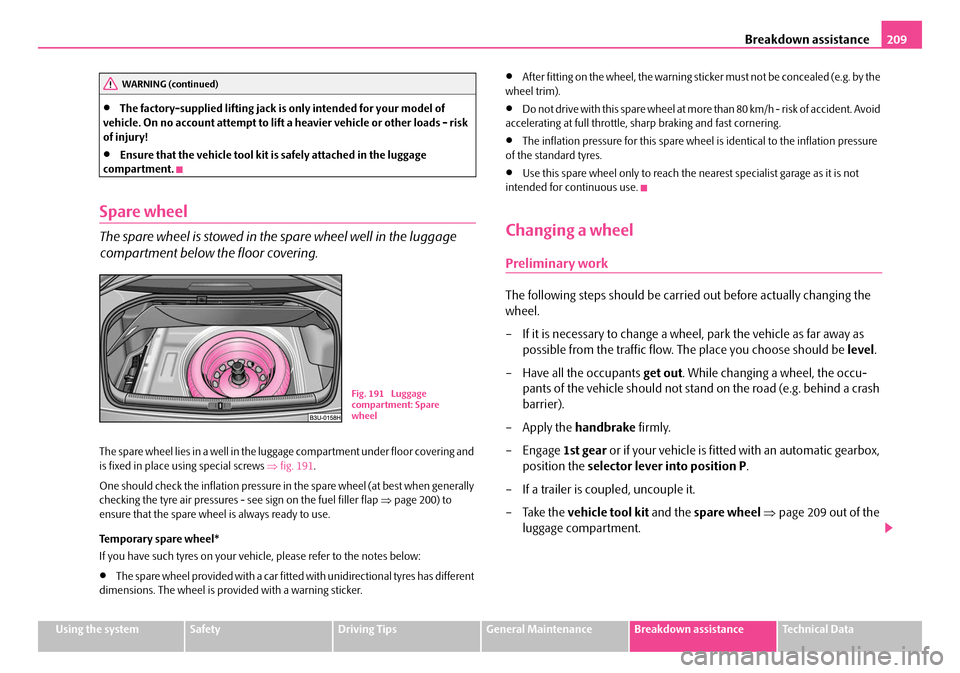
Breakdown assistance209
Using the systemSafetyDriving TipsGeneral MaintenanceBreakdown assistanceTechnical Data
•The factory-supplied lifting jack is only intended for your model of
vehicle. On no account attempt to lift a heavier vehicle or other loads - risk
of injury!
•Ensure that the vehicle tool kit is safely attached in the luggage
compartment.
Spare wheel
The spare wheel is stowed in the spare wheel well in the luggage
compartment below the floor covering.
The spare wheel lies in a well in the luggage compartment under floor covering and
is fixed in place using special screws ⇒fig. 191 .
One should check the inflation pressure in the spare wheel (at best when generally
checking the tyre air pressures - see sign on the fuel filler flap ⇒page 200) to
ensure that the spare wheel is always ready to use.
Temporary spare wheel*
If you have such tyres on your vehicle, please refer to the notes below:
•The spare wheel provided with a car fitted with unidirectional tyres has different
dimensions. The wheel is provided with a warning sticker.
•After fitting on the wheel, the warning st icker must not be concealed (e.g. by the
wheel trim).
•D o n o t d r i v e w i t h th i s s p a re w h e e l a t m o re th a n 8 0 k m / h - ri s k o f a c c i d e n t. Av o i d
accelerating at full throttle, sharp braking and fast cornering.
•The inflation pressure for this spare wheel is identical to the inflation pressure
of the standard tyres.
•Use this spare wheel only to reach the nearest specialist garage as it is not
intended for continuous use.
Changing a wheel
Preliminary work
The following steps should be carried out before actually changing the
wheel.
– If it is necessary to change a wheel, park the vehicle as far away as possible from the traffic flow. The place you choose should be level.
– Have all the occupants get out. While changing a wheel, the occu-
pants of the vehicle should not stan d on the road (e.g. behind a crash
barrier).
– Apply the handbrake firmly.
–Engage 1st gear or if your vehicle is fitted with an automatic gearbox,
position the selector lever into position P.
– If a trailer is coupled, uncouple it.
– Take the vehicle tool kit and the spare wheel ⇒ page 209 out of the
luggage compartment.
WARNING (continued)
B1Z-0042HB1Z-0042H
Fig. 191 Luggage
compartment: Spare
wheel
NKO B5 20.book Page 209 Friday, March 2, 2007 1:46 PM
Page 212 of 259

Breakdown assistance211
Using the systemSafetyDriving TipsGeneral MaintenanceBreakdown assistanceTechnical Data
Note
•If you find, when changing the wheel, that the wheel bolts are corroded and
difficult to turn, the bolts mu st be replaced before checking the tightening torque.
•Drive cautiously and only at a moderate speed to a workshop where the tight-
ening torque can be checked.
Full wheel trim*
Pulling off
– Hook the clamp (found in the vehicle toolkit) into the reinforced edge of the full wheel trim.
– Push the wheel key through the clamp, support the wheel key at the tyre and pull off the wheel trim.
Installing
– First press the full wheel trim onto the wheel at the valve opening provided. Then press the full wheel trim into the wheel in such a way
that its entire circumference locks correctly in place.
Caution
•Use the pressure of your hand, do not knock on the full wheel trim! Heavy
knocks mainly on the points where the full wheel trim has not been inserted into
the wheel, can result in damage to the guide and centering elements of the full
wheel trim.
•First check for yourself that the th eft-deterrent wheel bolt is located
⇒ page 214, “Securing wheels against being stolen” in the hole in the area of the
valve before fitting the full wheel trim onto a steel wheel which is attached with a
theft-deterrent wheel bolt.
Wheel trim caps*
Pulling off
– Carefully ⇒fig. 192 lever off the wheel trim cap using the removal
hook .
Wheel bolts with caps*
The caps are designed to protect the wheel bolts.
B1Z-0042HB1Z-0042H
Fig. 192 Changing a
wheel: Pulling off the
wheel trim cap
B1Z-0042HB1Z-0042HFig. 193 Changing a
wheel: Removing the cap
NKO B5 20.book Page 211 Friday, March 2, 2007 1:46 PM
Page 214 of 259
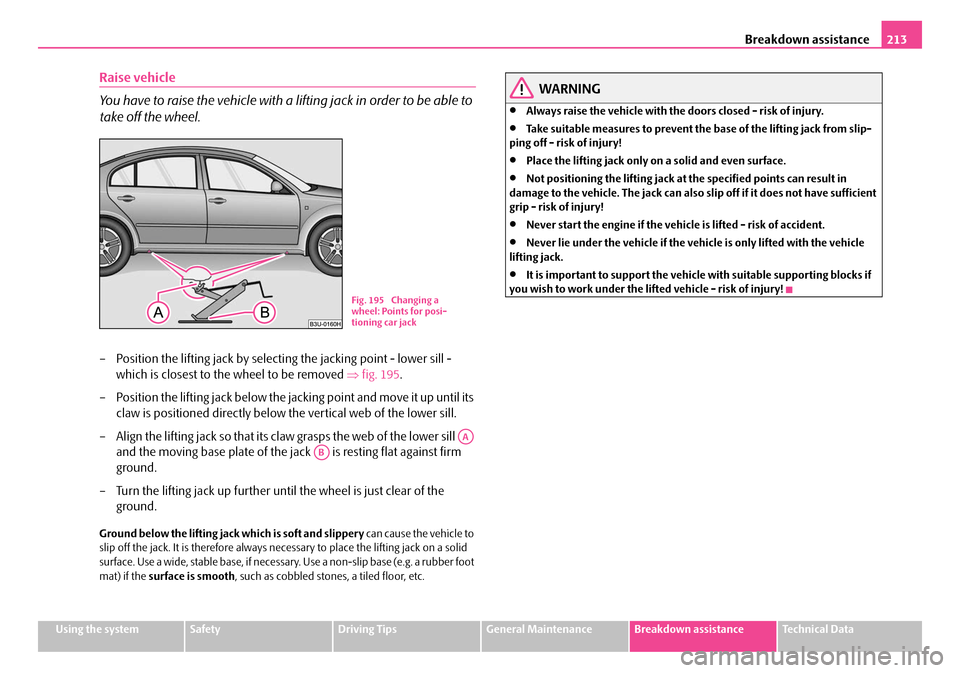
Breakdown assistance213
Using the systemSafetyDriving TipsGeneral MaintenanceBreakdown assistanceTechnical Data
Raise vehicle
You have to raise the vehicle with a lifting jack in order to be able to
take off the wheel.
– Position the lifting jack by selecting the jacking point - lower sill -
which is closest to the wheel to be removed ⇒fig. 195 .
– Position the lifting jack below the jacking point and move it up until its claw is positioned directly below the vertical web of the lower sill.
– Align the lifting jack so that its claw grasps the web of the lower sill and the moving base plate of the ja ck is resting flat against firm
ground.
– Turn the lifting jack up further until the wheel is just clear of the ground.
Ground below the lifting jack which is soft and slippery can cause the vehicle to
slip off the jack. It is therefore always ne cessary to place the lifting jack on a solid
surface. Use a wide, stable base, if necessary. Use a non-slip base (e.g. a rubber foot
mat) if the surface is smooth , such as cobbled stones, a tiled floor, etc.
WARNING
•Always raise the vehicle with the doors closed - risk of injury.
•Take suitable measures to prevent the base of the lifting jack from slip-
ping off - risk of injury!
•Place the lifting ja ck only on a solid and even surface.
•Not positioning the lifting jack at the specified points can result in
damage to the vehicle. The jack can also sl ip off if it does not have sufficient
grip - risk of injury!
•Never start the engine if the vehicl e is lifted - risk of accident.
•Never lie under the vehicle if the vehicle is only lifted with the vehicle
lifting jack.
•It is important to support the vehicle with suitable supporting blocks if
you wish to work under the lifted vehicle - risk of injury!
Fig. 195 Changing a
wheel: Points for posi-
tioning car jack
AA
AB
NKO B5 20.book Page 213 Friday, March 2, 2007 1:46 PM
Page 216 of 259
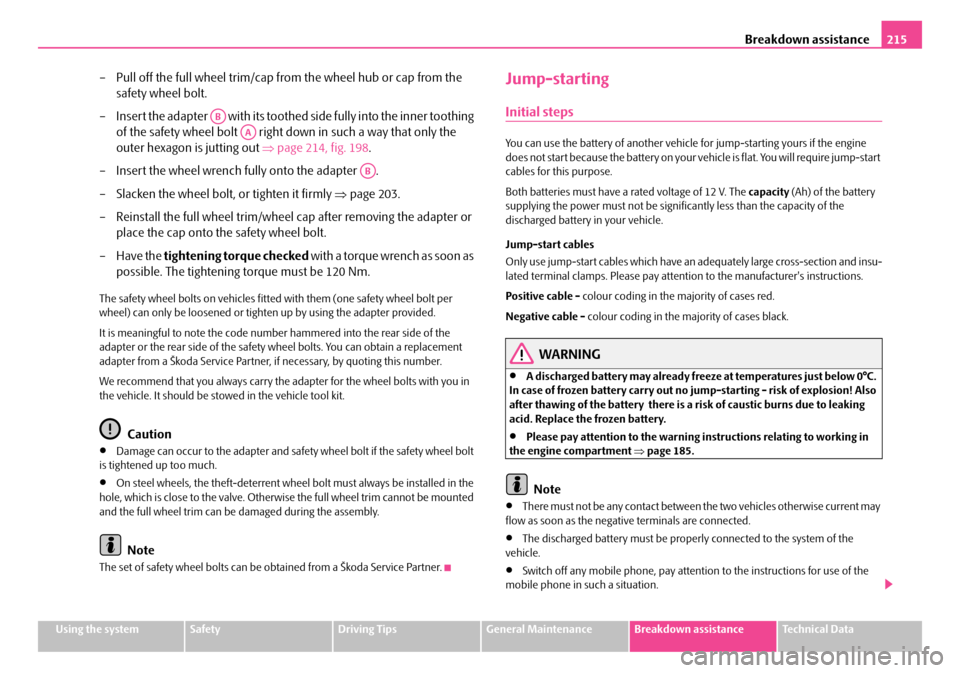
Breakdown assistance215
Using the systemSafetyDriving TipsGeneral MaintenanceBreakdown assistanceTechnical Data
– Pull off the full wheel trim/cap from the wheel hub or cap from the
safety wheel bolt.
– Insert the adapter with its toothed side fully into the inner toothing of the safety wheel bolt right do wn in such a way that only the
outer hexagon is jutting out ⇒page 214, fig. 198 .
– Insert the wheel wrench fully onto the adapter .
– Slacken the wheel bolt, or tighten it firmly ⇒page 203.
– Reinstall the full wheel trim/wheel cap after removing the adapter or place the cap onto the safety wheel bolt.
–Have the tightening torque checked w i t h a t o rq u e w re n c h a s s o o n a s
possible. The tightening torque must be 120 Nm.
The safety wheel bolts on vehicles fitted with them (one safety wheel bolt per
wheel) can only be loosened or tighten up by using the adapter provided.
It is meaningful to note the code numb er hammered into the rear side of the
adapter or the rear side of the safety wheel bolts. You can obtain a replacement
adapter from a Škoda Service Partner, if necessary, by quoting this number.
We recommend that you alwa ys carry the adapter for the wheel bolts with you in
the vehicle. It should be st owed in the vehicle tool kit.
Caution
•Damage can occur to the adapter and safety wheel bolt if the safety wheel bolt
is tightened up too much.
•On steel wheels, the theft-deterrent wheel bolt must always be installed in the
hole, which is close to the valve. Otherwise the full wheel trim cannot be mounted
and the full wheel trim can be damaged during the assembly.
Note
The set of safety wheel bolts can be obtained from a Škoda Service Partner.
Jump-starting
Initial steps
You can use the battery of another vehicl e for jump-starting yours if the engine
does not start because the battery on your vehicle is flat. You will require jump-start
cables for this purpose.
Both batteries must have a rated voltage of 12 V. The capacity (Ah) of the battery
supplying the power must not be signif icantly less than the capacity of the
discharged battery in your vehicle.
Jump-start cables
Only use jump-start cables which have an adequately large cross-section and insu-
lated terminal clamps. Please pay attention to the manufacturer's instructions.
Positive cable - colour coding in the majority of cases red.
Negative cable - colour coding in the majority of cases black.
WARNING
•A discharged battery may already freez e at temperatures just below 0°C.
In case of frozen battery carry out no jump-starting - risk of explosion! Also
after thawing of the battery there is a risk of caustic burns due to leaking
acid. Replace the frozen battery.
•Please pay attention to the warning instructions relating to working in
the engine compartment ⇒page 185.
Note
•There must not be any contact between the two vehicles otherwise current may
flow as soon as the negative terminals are connected.
•The discharged battery must be proper ly connected to the system of the
vehicle.
•Switch off any mobile phone, pay attent ion to the instructions for use of the
mobile phone in such a situation.
AB
AA
AB
NKO B5 20.book Page 215 Friday, March 2, 2007 1:46 PM
Page 218 of 259
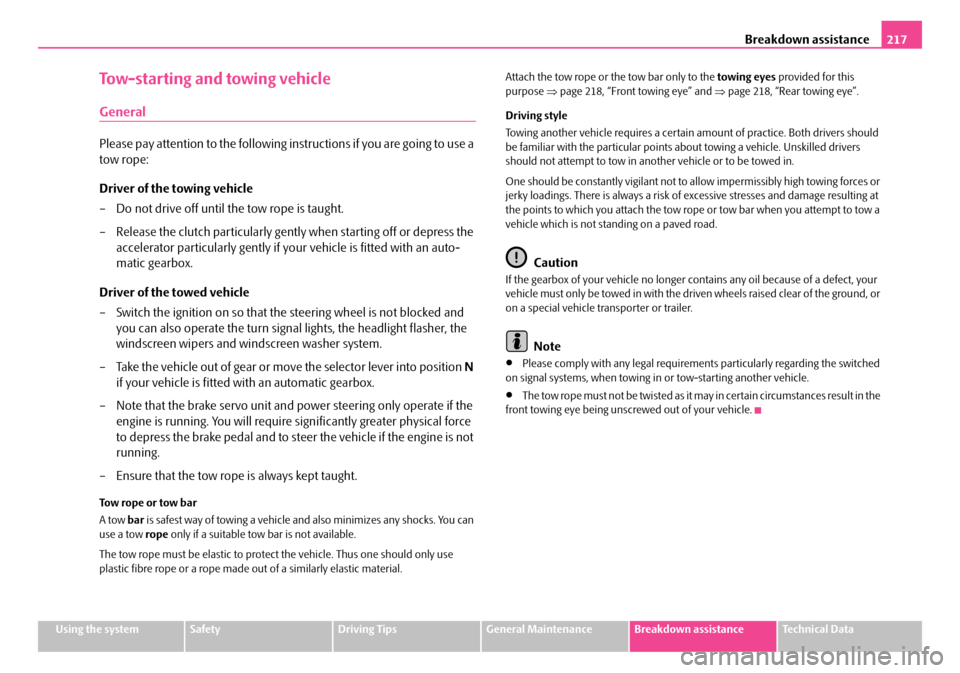
Breakdown assistance217
Using the systemSafetyDriving TipsGeneral MaintenanceBreakdown assistanceTechnical Data
Tow-starting and towing vehicle
General
Please pay attention to the following in structions if you are going to use a
tow rope:
Driver of the towing vehicle
– Do not drive off until the tow rope is taught.
– Release the clutch particularly gent ly when starting off or depress the
accelerator particularly gently if yo ur vehicle is fitted with an auto-
matic gearbox.
Driver of the towed vehicle
– Switch the ignition on so that the steering wheel is not blocked and you can also operate the turn signal lights, the headlight flasher, the
windscreen wipers and windscreen washer system.
– Take the vehicle out of gear or move the selector lever into position N
if your vehicle is fitted with an automatic gearbox.
– Note that the brake servo unit and power steering only operate if the engine is running. You will require si gnificantly greater physical force
to depress the brake pedal and to steer the vehicle if the engine is not
running.
– Ensure that the tow rope is always kept taught.
Tow rope or tow bar
A tow bar is safest way of towing a vehicle and also minimizes any shocks. You can
use a tow rope only if a suitable to w bar is not available.
The tow rope must be elastic to protect the vehicle. Thus one should only use
plastic fibre rope or a rope made out of a similarly elastic material. Attach the tow rope or the tow bar only to the
towing eyes provided for this
purpose ⇒page 218, “Front towing eye” and ⇒page 218, “Rear towing eye”.
Driving style
Towing another vehicle requires a certain amount of practice. Both drivers should
be familiar with the partic ular points about towing a vehicle. Unskilled drivers
should not attempt to tow in another vehicle or to be towed in.
One should be constantly vigi lant not to allow impermissibly high towing forces or
jerky loadings. There is always a risk of excessive stresses and damage resulting at
the points to which you attach the tow rope or tow bar when you attempt to tow a
vehicle which is not stan ding on a paved road.
Caution
If the gearbox of your vehicle no longer contains any oil because of a defect, your
vehicle must only be towed in with the driven wheels raised clear of the ground, or
on a special vehicle transporter or trailer.
Note
•Please comply with any legal requiremen ts particularly regarding the switched
on signal systems, when towing in or tow-starting another vehicle.
•The tow rope must not be twisted as it may in certain circumstances result in the
front towing eye being unscrewed out of your vehicle.
NKO B5 20.book Page 217 Friday, March 2, 2007 1:46 PM
Page 220 of 259

Breakdown assistance219
Using the systemSafetyDriving TipsGeneral MaintenanceBreakdown assistanceTechnical Data
•Move selector lever into N .
•The maximum towing speed is 50 km/h.
•The maximum permissible towing distance is 50 km. The gear oil pump does
not operate when the engine is not running and the gear would not be adequately
lubricated at higher speeds an d over longer towing distance.
Caution
If the vehicle is towed in by a recovery vehi cle, it should only be towed in with the
front wheels raised. If the vehicle is raised at rear, the automatic gearbox is
damaged!
Note
The vehicle must be transported on a special ve hicle or trailer if it is not possible to
tow in the vehicle in the way described or if the towing distance is greater than
50 km.
NKO B5 20.book Page 219 Friday, March 2, 2007 1:46 PM
Page 222 of 259
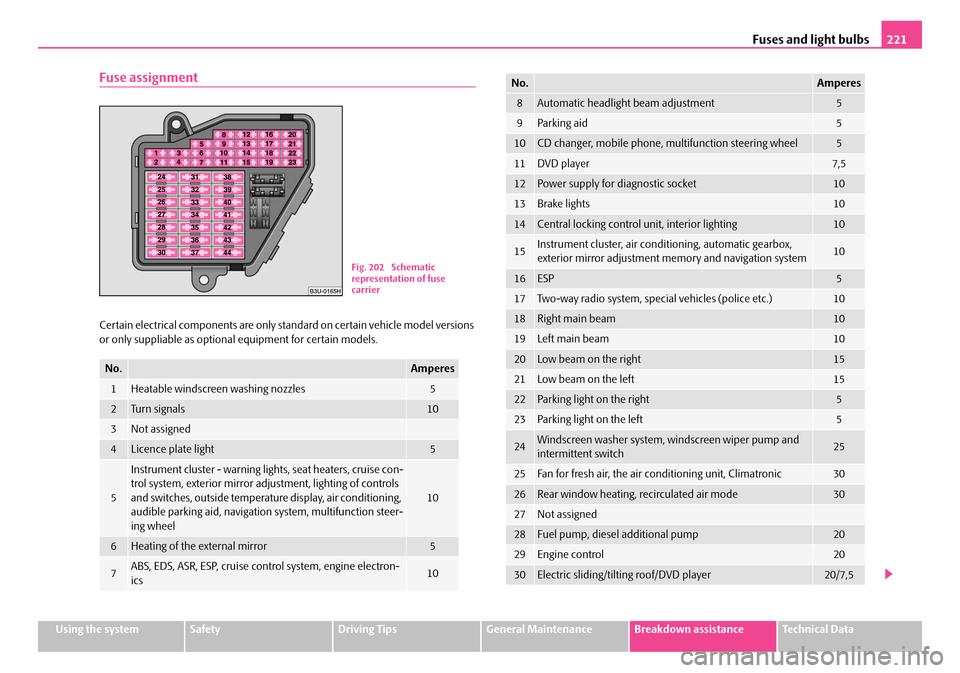
Fuses and light bulbs221
Using the systemSafetyDriving TipsGeneral MaintenanceBreakdown assistanceTechnical Data
Fuse assignment
Certain electrical components are only standard on certain vehicle model versions
or only suppliable as optional equipment for certain models.
No.Amperes
1Heatable windscreen washing nozzles5
2Tu r n s i g n a l s10
3Not assigned
4Licence plate light5
5
Instrument cluster - warning ligh ts, seat heaters, cruise con-
trol system, exterior mirror ad justment, lighting of controls
and switches, outside temperature display, air conditioning,
audible parking aid, navigation system, multifunction steer-
ing wheel
10
6Heating of the external mirror5
7ABS, EDS, ASR, ESP, cruise co ntrol system, engine electron-
ics10
Fig. 202 Schematic
representation of fuse
carrier
8Automatic headlight beam adjustment5
9Parking aid5
10CD changer, mobile phone, multifunction steering wheel5
11DVD player7,5
12Power supply for diagnostic socket10
13Brake lights10
14Central locking control unit, interior lighting10
15Instrument cluster, air cond itioning, automatic gearbox,
exterior mirror adjustment memory and navigation system10
16ESP5
17Two-way radio system, special vehicles (police etc.)10
18Right main beam10
19Left main beam10
20Low beam on the right15
21Low beam on the left15
22Parking light on the right5
23Parking light on the left5
24Windscreen washer system, windscreen wiper pump and
intermittent switch25
25Fan for fresh air, the air co nditioning unit, Climatronic30
26Rear window heating, recirculated air mode30
27Not assigned
28Fuel pump, diesel additional pump20
29Engine control20
30Electric sliding/tilting roof/DVD player20/7,5
No.Amperes
NKO B5 20.book Page 221 Friday, March 2, 2007 1:46 PM
Page 224 of 259
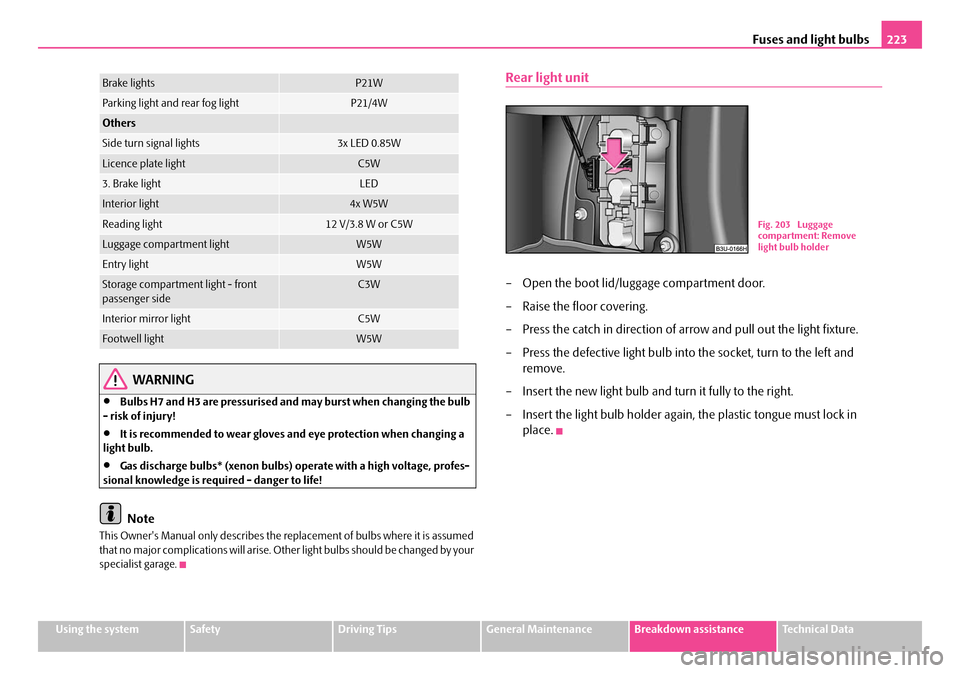
Fuses and light bulbs223
Using the systemSafetyDriving TipsGeneral MaintenanceBreakdown assistanceTechnical Data
WARNING
•Bulbs H7 and H3 are pressurised and may burst when changing the bulb
- risk of injury!
•It is recommended to wear gloves and eye protection when changing a
light bulb.
•Gas discharge bulbs* (xenon bulbs) operate with a high voltage, profes-
sional knowledge is required - danger to life!
Note
This Owner's Manual only describes the replacement of bulbs where it is assumed
that no major complications will arise. Other light bulbs should be changed by your
specialist garage.
Rear light unit
– Open the boot lid/luggage compartment door.
– Raise the floor covering.
– Press the catch in direction of arrow and pull out the light fixture.
– Press the defective light bulb into the socket, turn to the left and remove.
– Insert the new light bulb and turn it fully to the right.
– Insert the light bulb holder again, the plastic tongue must lock in place.
Brake lightsP21W
Parking light and rear fog lightP21/4W
Others
Side turn signal lights3x LED 0.85W
Licence plate lightC5W
3. Brake lightLED
Interior light4x W5W
Reading light12 V/3.8 W or C5W
Luggage compartment lightW5W
Entry lightW5W
Storage compartment light - front
passenger sideC3W
Interior mirror lightC5W
Footwell lightW5W
B1Z-0042HB1Z-0042H
Fig. 203 Luggage
compartment: Remove
light bulb holder
NKO B5 20.book Page 223 Friday, March 2, 2007 1:46 PM